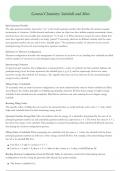General Chemistry: Subshells and More
Spin Quantum Number
The spin quantum number, denoted as “m,” is the fourth quantum number that describes the intrinsic angular
momentum of electrons. Unlike classical mechanics, where an object can have infinite angular momentum values,
electrons have only two possible spin orientations: +1/2 and -1/2. When electrons occupy the same orbital, they
must have opposite spins, referred to as being “paired.” Conversely, electrons in different orbitals with the same
spin quantum number (m) are said to have “parallel spins.” The maximum number of electrons in the second
principal energy level can be noted using these quantum numbers.
Definition of Electron Configuration
Electron configuration describes the arrangement of electrons in an atom or ion, detailing how subshells are filled
and the number of electrons in each principal energy level and subshell.
Spectroscopic Notation
In spectroscopic notation, the configuration is represented by a series of symbols: the first number indicates the
principal energy level, the letter represents the subshell type (s, p, d, f), and the superscript shows how many
electrons occupy that subshell. For instance, “2p” signifies that there are four electrons in the second principal
energy level’s p subshell.
Filling Order of Subshells
To accurately write an atom’s electron configuration, one must understand the order in which subshells are filled.
According to the Aufbau principle (or building-up principle), electrons fill from lower-energy to higher-energy
subshells. Each subshell must be completely filled before electrons can start entering the next higher-energy
subshell.
Recalling Filling Order
The specific order of filling does not need to be memorized due to useful methods such as the n + l rule, which
helps rank subshells based on their increasing energy levels.
Quantum Number Energy Rule This rule indicates that the energy of a subshell is determined by the sum of its
principal quantum number (n) and azimuthal quantum number (l), expressed as n + l. The lower the value of n + l,
the lower the energy of the subshell. This principle is essential for predicting which subshell will fill with electrons
first during the electron configuration process.
Filling Order of Subshells When comparing two subshells with the same n + l value, the subshell with the lower
principal quantum number (n) will have a lower energy and will fill first. For example, when determining whether
the 5d or 6s subshell fills first:
For 5d: n = 5 and l = 2, thus n + l = 7.
For 6s: n = 6 and l = 0, thus n + l = 6. Since 6s has a lower n + l value, it will fill before 5d.
Reading Electron Configurations from the Periodic Table An alternative method for determining electron
configurations involves using the periodic table directly. Key points include:
The lowest s subshell is 1s.
, The lowest p subshell is 2p.
The lowest d subshell is 3d.
The lowest f subshell is 4f.
By understanding these positions and reading across the periodic table, one can determine how to fill subshells
correctly while accounting for elements in both lanthanide and actinide series (the f block).
Graphic Design of the Periodic Table In most representations of the periodic table, the f block is positioned below
the main body of the table. This design choice is primarily for aesthetic reasons; placing the f block in its correct
position would create significant white space, making it less visually appealing.
Positioning of the f Block The f block elements are situated between the s block and d block in the periodic table.
This placement reflects their electron configurations and helps to organize elements based on their chemical
properties.
Abbreviated Electron Configurations Electron configurations can be simplified by using brackets to denote the
nearest noble gas preceding an element. For instance, for elements in period four, one can start with [Ar] (argon)
when writing their electron configurations.
Example: Electron Configuration of Osmium To find the electron configuration for osmium (atomic number 76),
we identify that xenon (atomic number 54) is the noble gas before osmium. Thus, we begin with [Xe]. The
configuration continues through filling the 6s subshell (with cesium and barium), then progresses into the 4f
subshell (the lanthanide series), and finally into the 5d subshell where osmium resides.
Osmium Electron Configuration Osmium is the sixth element in the 5d subshell, and its electron configuration can
be written as [Xe] 4f14 5d6. This notation indicates that osmium has a total of six electrons in the 5d subshell,
following the noble gas core of xenon (Xe).
Electron Configuration for Ions When writing the electron configuration for ions, different rules apply based on
whether the ion is negatively charged (anion) or positively charged (cation).
1. Anions: For negatively charged ions, additional electrons are added to the existing configuration according to
standard filling rules. For example, fluorine (F) has an electron configuration of [He] 2s2 2p5. When it gains an
electron to become F-, the configuration becomes [He] 2s2 2p6.
2. Cations: The process for positively charged ions is slightly more complex. To determine the electron
configuration of a cation:
Start with the neutral atom’s configuration.
Remove electrons from the subshells with the highest principal quantum number (n) first.
If there are multiple subshells tied for the highest n value, remove electrons from the subshell with the
highest angular momentum quantum number (l).
For example, to find the electron configuration of Fe3+:
The neutral iron atom has an electron configuration of [Ar] 4s2 3d6.
Since we need to remove three electrons, we first remove two from the 4s subshell (which has a higher
principal quantum number than 3d), leaving us with one more electron to remove from the 3d subshell.
Thus, Fe3+ has an electron configuration of [Ar] 3d5.
In summary:




